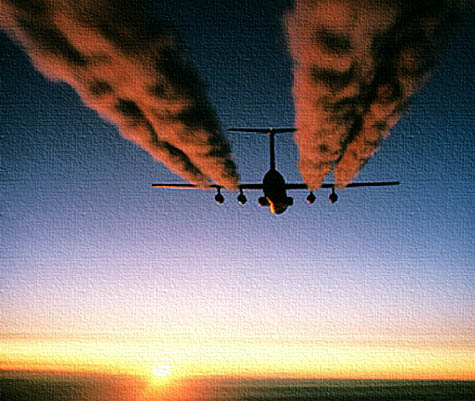 [Image: A C-141 Starlifter flying toward sunset; via Wikimedia].
[Image: A C-141 Starlifter flying toward sunset; via Wikimedia].
A cloud of metal dust released by U.S. military airplanes in the skies 100 miles west of Los Angeles caused a temporary blackout in the city and "interfer[ed] with radar at airports in southern California" when the cloud began blowing back toward land.
What exactly was the purpose of this inadvertently weaponized offshore atmospheric event? "The Navy says it spread several thousand pounds of the particles of chaff in an operation 100 to 300 miles offshore designed to test its ability to jam radar," the New York Times reported.
However, all of this actually occurred 25 years ago, in January 1985; I simply stumbled upon it while researching blackouts.
The idea, though, that there are airplanes flying somewhere out there west of Los Angeles creating strange weather for those of us on shore—clouds sculpted on the rising winds of the Southland, drifting unpredictably toward Santa Monica—seems both extraordinary and all too ready for capitalization. Sunsets on demand! Your least favorite celebrity gets married on a Malibu terrace and repurposed military aircraft paint the distant skies red, weaving fantastic ribbons of color in front of the falling sun.
It's like something out of J.G. Ballard's old short story "The Cloud Sculptors of Coral D," in which famous portraits are carved into passing cloud forms by trained kite operators standing below on the shores of a tropical island. They have invented a stunning, lo-fi, vernacular 3D printing that can only be applied to the earth's atmosphere.
“Lifted on the shoulders of the air above the crown of Coral D, we would carve seahorses and unicorns, the portraits of presidents and film stars, lizards and exotic birds,” Ballard wrote, describing this new mythology of atmospheric design and the "manicurists of the air" who so beautifully practiced it.
Or, for that matter, perhaps this strange meteorological event—the metal chaff of a new weather emperor, self-installed atop his flying throne, deploying cloud-weapons across the horizon—was an electromagnetically active twist on the anti-hero from Roberto Bolaño's novel Distant Star. There, we meet a skywriting poet-pilot with a penchant for fascism who sells his political soul to the Nazis in order to write his Romantic words in huge drifting scripts above the mountains of South America.
He becomes "a Michelangelo of the sky,” as Ballard might have it.
Meanwhile, radar-jamming clouds of nanoparticles settle onto the plates of outdoor diners in Venice Beach, salting take-out pizzas and dusting the bodies of sunbathers, as screens inside the LAX control tower madly ping with invisible aircraft.
Lưu trữ Blog
-
▼
2010
(3068)
-
▼
tháng 1
(209)
- Jag ♥ Snö
- Happy Birthday Felise!
- Banking on it (and a giveaway)
- Wilson Joseph Woog Esq.
- Week Ending Jan 31
- pavilion.net
- Det är alltid bra att slipa lite på envisheten
- THE TALLEST MAN ON EARTH - KING OF SPAIN
- Pest eller kolera?
- Twin Mountain Trudge II
- Swarm of bees
- New tiny snail
- Playlist - 30th January 2010
- A victory of love
- Cykelvick och annat bra
- Transferred Northern White Rhinos are Dehorned
- iPhad
- Lunar Archaeology
- Our Lady of the Rocks
- Friday I´m in love
- Counting Cards... Er, Stickers
- THE SANDWICH
- Semelhistorien
- Why Indeed
- JULIANNA BARWICK - SUNLIGHT, HEAVEN
- Inside Donkey Kong stage 3
- I think someone is missing here Kim......... ME
- My school site- when did "transparency" become a d...
- Foodprint NYC
- Den faktiska träningstiden
- Steam Tunnel Music
- The Great Baguette Disaster of 2009
- Oh no!
- Too Much Was Not Enough
- Wax on wax on wax on - and a bit of wax off with h...
- Hur ska de här gå nu då?!
- Ache
- Tama-Re, or the Egypt of the West
- MAGNETIC FIELDS - YOU MUST BE OUT OF YOUR MIND
- Inside Donkey Kong stage 2
- beauty breathe
- Architecture of a Decade Past
- Homefront Dissolve
- Cats are rubbish at painting
- CANDIE - EASYMAG #1
- CARIBOU - ODESSA
- Alla dagar är löpningens dagar..
- The Right Printhead
- Ducks must be existentialists
- The Padre Pocket
- Som på moln
- Mat- & bakdag
- Week Ending Jan 24
- Quick Links 3
- For Malmberg publishers
- Inside Rainbow Islands
- Austrian Times readers don't like snow!
- Vogue V Playboy
- The Pack Cycle Pocket Hypothesis
- Everyone! Out of the water!
- And the winner is....
- Playlist - 23rd January 2010
- Sött & syrligt
- Jag fortsätter broträna
- Inside Scramble
- The Self-Consuming Barbecue Pavilion
- States of Metamorphosis
- The Unnatural History of the Kakapo
- What do Ducks think?
- The Curious Collation of Rick Cerone
- Tack för det!!
- Hypothetically speaking
- Howard and his cool Storage World
- Interview with Bob Lemke, Vintage Card Editor at S...
- Suck och stön
- Jag drömmer mig bort
- Glacier / Island / Storm
- Can you make a noise like a frog?
- Tricky Dicky
- Oj då..
- Life, the universe and everything
- And now things get interesting
- They Will Build Clouds For Us
- TORO Y MOI - BLESSA
- PHOTOGRAPHY OF OLAF BREUNING
- Tisdag? Måndag?
- To minus your boombah..enter my blog giveaway!
- Ghost Town 38.5
- Week edning Jan 17
- Wrestled from the mouth of a tiger
- The Greatest Photo in the History of Baseball
- Hobby
- Right now
- Sheltered from the storm
- Frankie (of Jeremy and Frankie) has grown up...
- Super Powers Cultivate
- I am ready for Oymyakon
- 50 Single Stickers Can't Be Wrong
- Springdate
- Love is the drug
-
▼
tháng 1
(209)